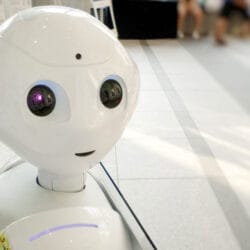All Aboard The AI Train, Just Be Aware Of The Ride Ahead
It’s a fast-moving world today and as AI technology moves us forward, increasingly, our jobs involve not just using computers, but having to learn many different programs (and AI capabilities) quickly just to keep up.
This isn’t something just programmers or designers have to do anymore, this is a growing challenge for practically everyone in our modern internet age, even before AI finds its way into every digital process.
Currently, even if you have a customer-facing role then chances are you have a computer in front of you that helps you book people in, process sales, obtain information, or allows you to speak to other colleagues in different departments etc. Farmers have to know more and more about technology to help automate processes. Train conductors use scanners and computers to ensure tickets are valid, and so on.
We already rely on technology so much in our jobs, but with the advance of AI many of us will have to work very differently to what we may have become accustomed to or finally settled in. Some may even have to choose new fields of work completely.
So, what can we do about it? These four simple steps will make the process of adapting to change in a fast-paced and AI technology-driven world much easier.
Step 1) Become Open To Change Rather Than Resist It
With change comes a choice. We can either look at it as a fear of the unknown, or the chance to grow.
If we fear the change around us then we only become prey to it. We resist rather than become resilient, anti-fragile, and then adaptable.
Of course, to accept more AI technology into our lives we don’t want to become automated zombies ourselves, essentially working for technology rather than technology working for us, and instead ideally want technology to help humanise us. Yet, if we aren’t conscious to changing surroundings we become more likely to fall into the grips of technology, and to the dopamine kicks that keep us locked in (like we have seen with social media addiction).
On the other hand, by becoming more open and conscious of how technology might be affecting us we can free ourselves from this trap, as we learn how to adapt to technology shifts quicker, become better at deciding which technology to invest into and which ones to just let slide, ensure we can break ourselves from technology to maintain a healthy balance, and realise that old, outdated ways of doing something (old habits, programs etc.) may not benefit us anymore (i.e. waste energy etc.).
Being more open to change helps us realign our energy so we can jump into something new and refreshing, rather than get stuck in past trends that no longer fit.
Do we really need to know how DVDs work when we stream everything today?
What about tomorrow? When we also begin to forward-think we can better pre-empt what future technology and living environments will be like, rather than wait too long to change.
You could wait in the same job for years and then suddenly one day be replaced by someone more adaptable, eager, and able to shift to new job requirements that you didn’t see coming, or even by AI capabilities that make part, or even all, of your job now redundant.
Resisting change is to resist the potential for growth which could be costly.
If your mindset was so against change, and against AI for that matter, you would not see the other side of the coin. The other side being how you can benefit your career by going with change and utilising it so you can use it to aid your progression (as we see further in step 3).
Step 2) Bring Down The Selection Process
We live in a world full of choice. Often too much. We may think it’s only rigidness that can stop us from adapting to change, but these days it’s often analysis-paralysis – having too many choices to start with.
It’s like trying to pick a movie on Netflix or Amazon Prime, or deciding on which app will help us the most when there are just so many now out there.
We simply can’t watch or use everything, and anyone whose gone through this ‘selection’ process of trialing an app to see if it’s right will know that too much choice only leads to a whole lot of procrastination through a lot of tinkering about, pushing buttons, adding more stuff to consume us, and often getting nowhere (whilst trying to convince ourselves we are getting more organised through technology and being productive).
Whilst being open to change is critical for our future success, and whilst our fast-changing world promotes an ever-increasing amount of technology to figure out, how then do we open our minds without becoming so (understandably) overwhelmed and distracted by all the choices and developments out there?
Many people are already burnt-out which is causing more resistance to change, so our next step needs to counteract this, and it is to decide what we actually want to focus on so we can make this process easier.
We will never know everything, and trying to will only overwhelm us. So, instead, we should consider where we want to build foundational knowledge, where we may want to build deeper knowledge and to accept what we simply don’t have time for.
How To Choose What To Focus On Effectively
The ‘Points Of Focus’ Method
One technique is to use a visual points method.
These points help us focus our attention on what matters most. It can help to allocate points to what we want to know, and to remove points away from something we already know well enough.
Give yourselves 10 points and allocate it to ‘points of focus’. You could give something you really want to focus on more points, but you only get 10 points, so allocate wisely.
This is similar to how sprint workshops work to make decisions based on votes, so time isn’t wasted on over-deliberation. You could do this for your daily goals too. Without purposefully guiding our focus most our time and energy (our points) is wasted on things that don’t really help us move forward.
Selecting The Right Programs For You
With more companies vying for attention, and more programs (and program features or makeovers) being added for you to try and keep up with, it is near impossible to keep up with everything released, and when it also takes time to learn just one app, program, or realm of knowledge, let alone keep up with general tech (like social media apps, email platforms, team collaboration programs, and other lifestyle apps), you can see why it’s important to be able to learn fast and adapt to changes quickly in a world where technology is always-on and always updating so fast.
Yet, one of the biggest blocks to learning efficiency is in overcrowding our mind so we aren’t fully focused on one thing enough to retain information on it. We too often now passively scan and move on, don’t repeat exposure enough, and certainly don’t critically think about what we have read or watched enough.
We are better to know a few things well with repeated interest rather than seeking instant gratification hits to new information passively, only to forget.
It’s as important to know how and when to say no. Don’t think you always have to catch up and know everything otherwise you risk learning nothing. It’s like trying to craft a perfect CV for a job you don’t even want. You are better to minimise your approach and to happily clear the clutter.
When you do find a subject or program of interest then you want to sprint decision it.
Firstly, envision your future life and see if that program or knowledge would be useful towards seeing that vision realised. If it doesn’t correlate then let it go. Consider the purpose, function, and feature set of a piece of technology before you even download it.
Often we just get caught up in bright shiny new lights and end up wasting time on something we know we don’t even really need at all.
If it still interests and correlates then quickly test it. Make this part enjoyable but short. You could watch a quick tutorial on it, or find a free trial and quickly test it out by trying to recreate an existing example, and being prepared to make mistakes, but also set a timer deadline to try and complete it in.
It doesn’t have to be as good as the original copy, but it should tell you enough about whether that tech is right for you to keep going with. You don’t need 5 apps doing the same thing, and so you can quickly test a few and then make a decision.
Then practice. To get good at something quickly continue to give yourself challenges and deadlines to finish a task. Make the task too easy, or think you have to do baby steps each day, and you will likely just give up as you won’t be making fast enough progress with it, and other new shiny toys start becoming more interesting to you again.
Lots of technology today uses the same transferable knowledge and so once you get good at one thing you’ll more likely learn and adapt to something else quicker, so keeping your mind sharp by active implementation is important.
Another tip would be to set your desktop and phone to ideally use apps that are cross-device friendly so you only have to learn one program, and place emphasis on the end goal and not on the extra functions the programs may have. Again, you don’t need to know everything, just what you need.
Use A Decision-Making Tool If Stuck
If you get stuck in selecting what to focus on, then you can simply make a decision quicker by using a dice to make the decision for you, or use a decision-making app.
But remember, the key to improving your decision-making is to not resist making a change in the first place, and to be open to just giving something a go. Taking the decision out of your hands only actually makes it harder for you to make decisions in the long run.
So, a good technique to help you here is to do the ‘3-second decision’ challenge throughout your day.
This will train your mind to think faster without guilt and with more initiative.
For example, you can start small by deciding what breakfast cereal to eat tomorrow morning. 3-2-1 and decide. Stick to the choice. You’ll soon see that most of our decision-making doesn’t need anywhere near as much thought as we give it, and does little to nothing to impact our lives (obviously big life decisions don’t apply in this technique).
Step 3) Be Open To Constant Learning And Collaboration
Effective learning is best when we use a mix of ‘green light red light’ thinking. We become open to our curiosity and then we seek to direct the curiosity towards more relevant channels.
That was essentially steps 1 and 2, but to get into the habit of active fast learning, especially when AI is involved in quickly delivering us results, we have to take this a bit further.
If we just become settled in what we know or think we know then it doesn’t take long until our new news is old news, and if we are honest, our one brain is no contender for a community of many brains, and a hub of infinite AI ‘brains’.
Trying to start up numerous businesses or write multiple books on your own certainly would take an age compared to the leveraged capability of multiple people, and an eternity compared to the continuously growing processing power of AI.
Collaboration with other humans is vital for us social beings. Other people know something you don’t and vice versa. When you want to learn new skills or find an answer to a problem, you can do it much quicker when you collaborate. It can help keep you in the loop and get you in touch with other people in a field of interest, and you’ll find learning information sits much quicker when you have to be accountable to someone else.
Yet, there’s a downside to collaboration too if you rely on the answers of others whilst not applying your own critical thinking, and you may be led into biases you didn’t realise. So, it’s important to keep fluctuating between your own thinking and the thinking of others, which is where the last step comes in.
Step 4) Use AI Technology To Remove Autopilot (& Filter What We Need)
Whilst AI technology is leading all of us in need of crafting a more adaptable and quick-thinking mindset, it’s the technology itself that can help us do just that.
We should not think of adapting to change in technology as a chore, but as an opportunity to develop our own human minds further and quicker than we could without this technology aiding us.
When we begin to see how AI technology can free us from the boring repetitiveness of daily chores – chores that lead us into a somewhat stifled and autopilot mindset – and instead can help us filter mindless actions and embrace our critical and creative thinking more, then we can fuel our potential so much further.
You see, a final key aspect of being able to adapt to fast-changing AI technology involves our human ability to problem-solve in a way AI can’t.
Sure, AI is going to be smarter than humans one day, likely soon, and it will be able to solve methodological problems much better than we can as humans, but it doesn’t need to be our enemy.
We are able to envision a better world with AI at our side doing the grunt work (and even paint some nice artwork along the way), but our ability to critically think, show empathy, and apply creativity to real-world problems does mean we are still ‘relevant’.
What we can do with AI is help us filter the overload of information, rather than add to it.
Before, as AI-less humans, we found ourselves using computers and having to be constantly filling in the blanks and having to repeat processes instead of them being automated.
With AI machine learning a lot of this work for humans becomes unnecessary, but crucially it frees our (rather limited) mind to keep in the adaptable learning mode much longer.
We won’t have to keep manually filtering what we don’t need, or get as lost in endless scrolls of useless information. Instead, with the right prompt engineering (and learned answers to bring up immediately instead of forgetting what we learned) we can find our world becomes closer to our vision without having to spend so much time repeating the same things over and over to get there.
Imagine a digital device that helps you adjust your day to the focus you set it, and cuts out the unnecessary noise around it. You wouldn’t even have to learn ‘faster’ as such because your mind would find it easier to focus on what matters and cut out what doesn’t.
This AI device might not quite be here just yet, but right now what we can do is consider how our time and energy can be enhanced by embracing new technology that seeks to make our job easier and more automated on the boring tasks, so we can focus our energy on being more creative and critical in our thinking.
For example, instead of spending hours and hours on writing an article or crafting a video, is there technology we can learn that can streamline that, and leave us more time to consider the quality of the content? It’s like getting eBay to automatically print your postage labels as soon as an order is placed. It needs doing, so why worry about such a repetitive and thankless task (although due diligence in service should still be a human touch).
So, if we want to adapt quicker to a fast-changing and AI-impacted world then we are best to embrace change, forward-think our learning, and use AI to help us make our decision-making process easier.
AI won’t replace our executive functioning, it will just make it more astute. Yet, we can’t lead towards any of this if we are resistant to change, so a good start is to open our brain up to think more openly, creatively, and differently.








